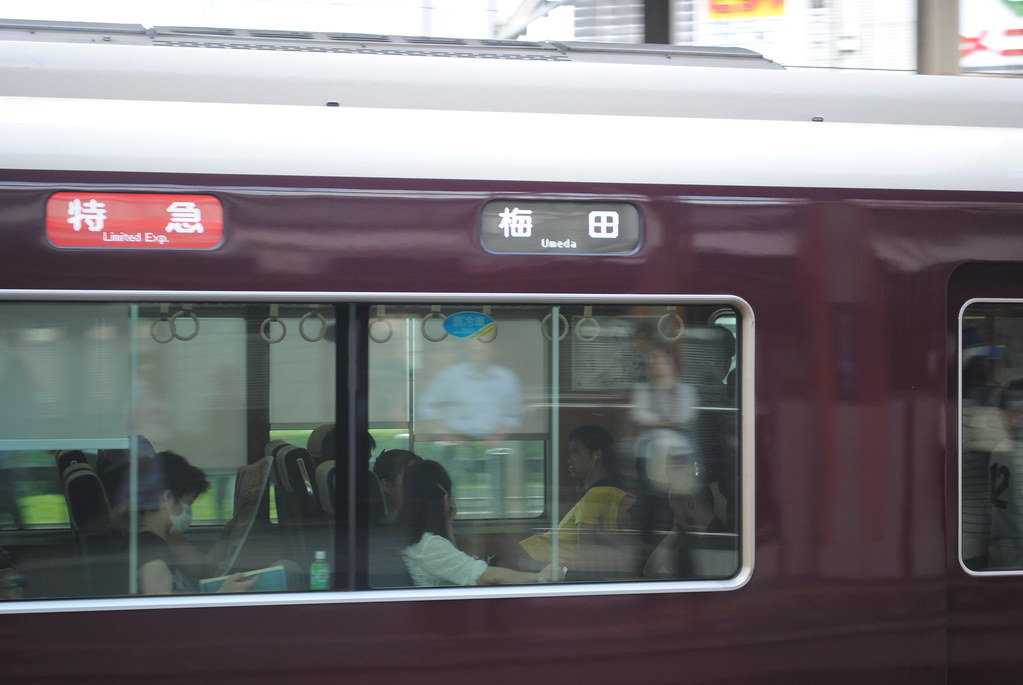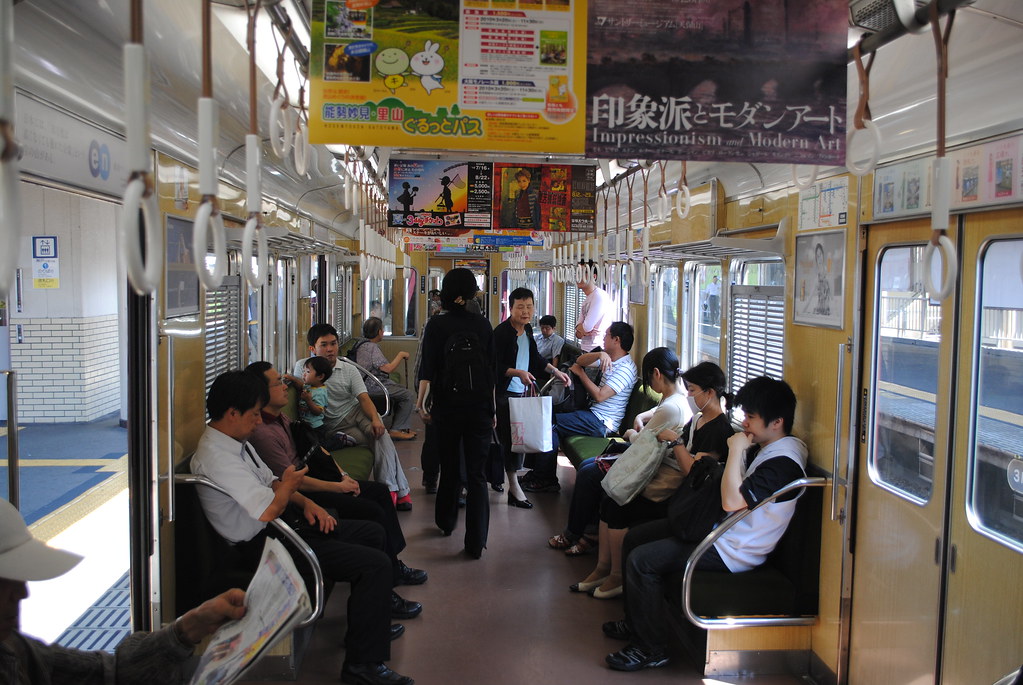One of the things that probably springs to mind when you think of Japan are 電車; probably the image of the 新幹線 (しんかんせん - shinkansen - bullet train) gliding past 富士山 (ふじさん - Fujisan - Mount Fuji), or men with white gloves shoving the last few passengers on to a packed train. You could say that 電車 are the backbone of Japan and when you get here, you'll see why - they get billions of people a year to where they need to be. Let's have a look at the Japanese rail system and see what makes it one of the best in the world.
There are three main train lines that run throughout 兵庫 (ひょうご - Hyogo) - 阪急 (はんきゅう - Hankyu), 阪神 (はんしん - Hanshin) and JR (Japan Railways). They're all run by private companies - 阪急 and 阪神 are now owned by the same one but still operate under separate banners. There are some smaller private companies as well, but for the most part it's a similar experience regardless of which you're on - the fares are almost identical and many of the stops are quite close together, particularly in the big city centres like 神戸 (こうべ - Kobe). The choice is usually made by whichever station is closest to your home or work - I spend most of my time on 阪急 for that reason. The subways of 兵庫 are municipally run, but they share some of their infrastructure with the private companies.
So why are 電車 such an integral part of Japanese society? The reason is simple, really - 電車 and 電車駅 (でんしゃえき - densha eki - train stations) have been around for so long that a lot of modern Japanese life has been built around them, rather than the other way around. Housing and residential areas have been built around train stations and public transport hubs for a long time, which is why using them is so convenient. They also mesh with the non-stop nature of Japan by running long into the night - many lines don't close until midnight and then they're open again at dawn. Beyond that, it's unusual for 電車駅 not to be attached to several businesses and restaurants - particularly the big stations. Some, like 三宮 (さんのみや - Sannomiya) and 大阪 (おおさか - Osaka), sprawl across several blocks both under and above ground; they yawn into huge shopping malls, hotels, floors of restaurants and walkways to the other lines' stations. In fact, some of the shops are owned by the rail companies themselves - there are 阪急 and 阪神 department stores, for example.
All of this has turned the humble 電車駅 into a hive of activity, making it even more sensible to live near one.
Whichever 電車駅 you end up in, there are a few things that you can expect. Firstly, the trains will run every few minutes and always arrive on the dot. If a train is even one minute late, announcements will come over the loudspeaker apologising for the delay. Any more than that and the train company may offer certificates to passengers to excuse their lateness. Noticeable delays can even make it into the newspaper!
Secondly, the different categories of trains are fairly consistent:
普通 (ふつう - futsuu) or 各駅停車 (かくえきていしゃ - kakueki teisha) - "local" trains that stop at every station.
快速 (かいそく - kaisoku) - slightly faster "rapid" trains that skip some stations.
急行 (きゅうこう - kyuukou) - "express" trains that only stop at larger stations.
特急 (とっきゅう - tokkyuu) - "limited express" trains that limit their stops to only the major stations on the line. This is short for 特別急行 (とくべつきゅうこう - tokubetsu kyuukou - "special express").
Even if you can't understand the word itself or the 漢字 (かんじ - kanji) on the train, they are usually colour coded - "local" will usually be written in blue or white, "rapid" and "express" in yellow and "limited express" in red.
Finally, the ticketing system is shared between the train lines - all use automatic gates. When you want to ride, it's a matter of heading over to the machines, finding the station you want to go on the map above and buying the ticket it tells you to. You put your ticket in the slot at the gate and grab it out again on the way through, then when you arrive at your destination, the machine swallows it up and lets you out. Should you try to sneak through without paying or use a ticket that's not enough to cover your fare, an alarm will sound and the gates will embarrassingly slam shut in front of your legs. To prevent this happening, there are nifty little machines at all train stations called のりこし清算機 (のりこしせいさんき - norikoshi seisanki) or "fare adjustment machines". Should you decide to change your destination midway, you can pop your ticket into them when you arrive there and they will automatically calculate whether you've paid enough or too much. This way, you can settle up quickly and easily and avoid everyone glaring at you.
Of course, you don't have to buy a ticket every time - you can buy prepaid cards that work across all train lines and subways, which means you don't have to fish for change or worry about which ticket to buy. There are also more permanent plastic cards of several types. The "postpaid" ones work like credit cards and send you a bill each month while those that are "prepaid" need to be loaded up with money beforehand. In both cases, these are used without feeding them into the machine - they are just touched to the electronic scanner on the ticket gate. A lot of Japanese people buy and use what's called a 定期券 (ていきけん - teikiken - commutation pass), which is valid for unlimited travel between certain train stations for a fixed period. As I said here, there are special seasonal passes that offer unlimited travel during certain dates and of course the famous JR Rail Pass is available to people visiting Japan, offering unlimited travel on JR trains including most of the 新幹線.
The 新幹線 are run exclusively by JR and are by far the quickest way of travelling long distances around Japan by rail. The busiest line is the 東海道 (とうかいどう - Toukaidou) line, which connects 東京 (とうきょう - Tokyo), 神戸 and 大阪. The whole process of riding the 新幹線 feels more formal than on regular 電車 - you can pay to reserve seats in what's called a グリーン車 (guriin sha - Green car) which gives you your own numbered seat in a roomier car, or you can just chance it in the unreserved section and hope there's a spare spot. The length of the trip from 東京 to 大阪 depends which type of 新幹線 you get:
こだま (Kodama) 新幹線 stop all stations and take about 4 hours to make the trip.
ひかり (Hikari) 新幹線 skip some stations and take about 3 hours and
のぞみ (Nozomi) 新幹線 only stop at the major stations and complete the trip in just under 2.5 hours.
Getting on one feels a bit more like getting on a plane in some ways - there are individual seats rather than benches like on many local trains and the cabin is sealed to make sure the trip is comfortable when you start roaring through tunnels. They even have food trolleys gliding up and down the aisles offering snacks and drinks. This is a very good opportunity to try 駅弁 (えきべん - ekiben) - a kind of 弁当 (べんとう - bentou - packed lunchbox) sold at train stations and some long-distance trains.
Finally, those two images that may have sprung to mind at the beginning of the article are absolutely true. On a clear day heading up to 東京 in the 東海道新幹線, you should be able to get a good look at 富士山 in the distance. Once there, or at another big city centre like 大阪, if you're (un)fortunate enough to find yourself boarding a rush hour train, you'll find the white gloved train guards who will politely but resolutely jam you through the doors wherever you'll fit. If you can see past the sea of arms and legs once inside, you'll also see them bow deeply as the train pulls away. They take their jobs very seriously, as does the rest of the 電車 industry - it wouldn't be a very good backbone if it didn't have some hard working discs.






No comments:
Post a Comment
If you have any questions or additions, I would love to hear from you. I may not know the answer, but I'll do my best to find out in any case! You can post anonymously if you like, but abusive/unintelligible/inappropriate comments will not be published.